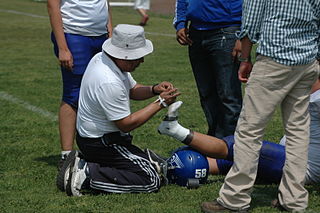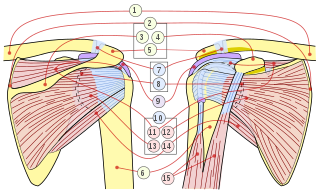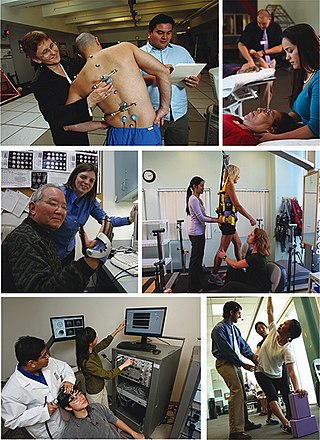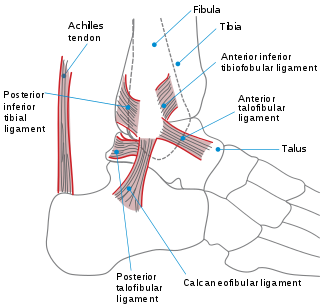Related Research Articles

Running is a method of terrestrial locomotion allowing humans and other animals to move rapidly on foot. Running is a type of gait characterized by an aerial phase in which all feet are above the ground. This is in contrast to walking, where one foot is always in contact with the ground, the legs are kept mostly straight and the center of gravity vaults over the stance leg or legs in an inverted pendulum fashion. A feature of a running body from the viewpoint of spring-mass mechanics is that changes in kinetic and potential energy within a stride co-occur, with energy storage accomplished by springy tendons and passive muscle elasticity. The term running can refer to any of a variety of speeds ranging from jogging to sprinting.

Sports injuries are injuries that occur during sport, athletic activities, or exercising. In the United States, there are approximately 30 million teenagers and children who participate in some form of organized sport. Of those, about three million athletes age 14 years and under experience a sports injury annually. According to a study performed at Stanford University, 21 percent of the injuries observed in elite college athletes caused the athlete to miss at least one day of sport, and approximately 77 percent of these injuries involved the knee, lower leg, ankle, or foot. In addition to those sport injuries, the leading cause of death related to sports injuries is traumatic head or neck occurrences.

Biomechanics is the study of the structure, function and motion of the mechanical aspects of biological systems, at any level from whole organisms to organs, cells and cell organelles, using the methods of mechanics. Biomechanics is a branch of biophysics.

The rotator cuff is a group of muscles and their tendons that act to stabilize the human shoulder and allow for its extensive range of motion. Of the seven scapulohumeral muscles, four make up the rotator cuff. The four muscles are:
Ulnar collateral ligament reconstruction, colloquially known as Tommy John surgery (TJS), is a surgical graft procedure where the ulnar collateral ligament in the medial elbow is replaced with either a tendon from elsewhere in the patient's body, or with one from a deceased donor. The procedure is common among collegiate and professional athletes in several sports, particularly in baseball. The surgery is performed to restore optimal function for repetitive elbow movements or specifically throwing ability, often extending the careers of professional athletes. In many athletes, the surgery is done more than once during their careers.

Gait analysis is the systematic study of animal locomotion, more specifically the study of human motion, using the eye and the brain of observers, augmented by instrumentation for measuring body movements, body mechanics, and the activity of the muscles. Gait analysis is used to assess and treat individuals with conditions affecting their ability to walk. It is also commonly used in sports biomechanics to help athletes run more efficiently and to identify posture-related or movement-related problems in people with injuries.

Kinesiology is the scientific study of human body movement. Kinesiology addresses physiological, anatomical, biomechanical, pathological, neuropsychological principles and mechanisms of movement. Applications of kinesiology to human health include biomechanics and orthopedics; strength and conditioning; sport psychology; motor control; skill acquisition and motor learning; methods of rehabilitation, such as physical and occupational therapy; and sport and exercise physiology. Studies of human and animal motion include measures from motion tracking systems, electrophysiology of muscle and brain activity, various methods for monitoring physiological function, and other behavioral and cognitive research techniques.

Stretching is a form of physical exercise in which a specific muscle or tendon is deliberately expanded and flexed in order to improve the muscle's felt elasticity and achieve comfortable muscle tone. The result is a feeling of increased muscle control, flexibility, and range of motion. Stretching is also used therapeutically to alleviate cramps and to improve function in daily activities by increasing range of motion.
Applied mechanics is the branch of science concerned with the motion of any substance that can be experienced or perceived by humans without the help of instruments. In short, when mechanics concepts surpass being theoretical and are applied and executed, general mechanics becomes applied mechanics. It is this stark difference that makes applied mechanics an essential understanding for practical everyday life. It has numerous applications in a wide variety of fields and disciplines, including but not limited to structural engineering, astronomy, oceanography, meteorology, hydraulics, mechanical engineering, aerospace engineering, nanotechnology, structural design, earthquake engineering, fluid dynamics, planetary sciences, and other life sciences. Connecting research between numerous disciplines, applied mechanics plays an important role in both science and engineering.

A sprained ankle is an injury where sprain occurs on one or more ligaments of the ankle. It is the most commonly occurring injury in sports, mainly in ball sports such as basketball, volleyball, football, and tennis.

An anterior cruciate ligament injury occurs when the anterior cruciate ligament (ACL) is either stretched, partially torn, or completely torn. The most common injury is a complete tear. Symptoms include pain, an audible cracking sound during injury, instability of the knee, and joint swelling. Swelling generally appears within a couple of hours. In approximately 50% of cases, other structures of the knee such as surrounding ligaments, cartilage, or meniscus are damaged.

Balance in biomechanics, is an ability to maintain the line of gravity of a body within the base of support with minimal postural sway. Sway is the horizontal movement of the centre of gravity even when a person is standing still. A certain amount of sway is essential and inevitable due to small perturbations within the body or from external triggers. An increase in sway is not necessarily an indicator of dysfunctional balance so much as it is an indicator of decreased sensorimotor control.

Musculoskeletal injury refers to damage of muscular or skeletal systems, which is usually due to a strenuous activity and includes damage to skeletal muscles, bones, tendons, joints, ligaments, and other affected soft tissues. In one study, roughly 25% of approximately 6300 adults received a musculoskeletal injury of some sort within 12 months—of which 83% were activity-related. Musculoskeletal injury spans into a large variety of medical specialties including orthopedic surgery, sports medicine, emergency medicine and rheumatology.

Elastic therapeutic tape, also called kinesiology tape or kinesiology therapeutic tape, Kinesio tape, k-tape, or KT is an elastic cotton strip with an acrylic adhesive that is purported to ease pain and disability from athletic injuries and a variety of other physical disorders. In individuals with chronic musculoskeletal pain, research suggests that elastic taping may help relieve pain, but not more than other treatment approaches, and no evidence indicates that it can reduce disability in chronic pain cases.
Eccentric training is a type of strength training that involves using the target muscles to control weight as it moves in a downward motion. This type of training can help build muscle, improve athletic performance, and reduce the risk of injury. An eccentric contraction is the motion of an active muscle while it is lengthening under load. Eccentric training is repetitively doing eccentric muscle contractions. For example, in a biceps curl the action of lowering the dumbbell back down from the lift is the eccentric phase of that exercise – as long as the dumbbell is lowered slowly rather than letting it drop.

Sprinting involves a quick acceleration phase followed by a velocity maintenance phase. During the initial stage of sprinting, the runners have their upper body tilted forward in order to direct ground reaction forces more horizontally. As they reach their maximum velocity, the torso straightens out into an upright position. The goal of sprinting is to reach and maintain high top speeds to cover a set distance in the shortest possible time. A lot of research has been invested in quantifying the biological factors and mathematics that govern sprinting. In order to achieve these high velocities, it has been found that sprinters have to apply a large amount of force onto the ground to achieve the desired acceleration, rather than taking more rapid steps.
Movement assessment is the practice of analysing movement performance during functional tasks to determine the kinematics of individual joints and their effect on the kinetic chain. Three-dimensional or two-dimensional analysis of the biomechanics involved in sporting tasks can assist in prevention of injury and enhancing athletic performance. Identification of abnormal movement mechanics provides physical therapists and Athletic trainers the ability to prescribe more accurate corrective exercise programs to prevent injury and improve exercise rehabilitation and progression following injury and assist in determining readiness to return to sport.

A kick is a skill in association football in which a player strikes the ball with their foot. Association football, more commonly referred to as football and also known as soccer, is a sport played world-wide, with up to 265 million people around the world participating on a yearly basis. Kicking is one of the most difficult skills to acquire in football. This skill is also vitally important, as kicking is the way in which passes are made and the primary means by which goals are scored.
Neuro Biomechanics is based upon the research of bioengineering researchers, neuro-surgery, orthopedic surgery and biomechanists. Neuro Biomechanics are utilized by neurosurgeons, orthopedic surgeons and primarily by integrated physical medicine practitioners. Practitioners are focused on aiding people in the restoration of biomechanics of the skeletal system in order to measurably improve nervous system function, health, function, quality of life, reduce pain and the progression of degenerative joint and disc disease.

Gideon Ariel is an Israeli authority in biomechanics, as well as a former Olympic track and field athlete who competed in the discus throw.
References
- 1 2 Boone, Tommy. "Basic Concepts in Sports Biomechanics". Archived from the original on 28 October 2011. Retrieved 27 October 2011.
- 1 2 "BASES - About Biomechanics". www.bases.org.uk. Retrieved 2017-12-13.
- 1 2 Knudson, Duane (2021). Fundamentals of Biomechanics. Cham: Springer International Publishing. doi:10.1007/978-3-030-51838-7. ISBN 978-3-030-51837-0.
- 1 2 Hewett, Timothy E.; Bates, Nathaniel A. (2017). "Preventive Biomechanics: A Paradigm Shift With a Translational Approach to Injury Prevention". The American Journal of Sports Medicine. 45 (11): 2654–2664. doi:10.1177/0363546516686080. ISSN 0363-5465. PMC 6405413 . PMID 28199800.
- 1 2 3 Frost, David M.; Cronin, John; Newton, Robert U. (2010-04-01). "A Biomechanical Evaluation of Resistance". Sports Medicine. 40 (4): 303–326. doi:10.2165/11319420-000000000-00000. ISSN 1179-2035.
- ↑ Zatsiorsky, Vladimir (2008-04-15). Biomechanics in Sport: Performance Enhancement and Injury Prevention. John Wiley & Sons. ISBN 978-0-470-69304-9.